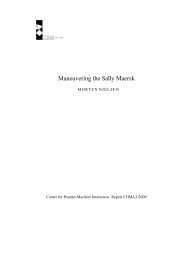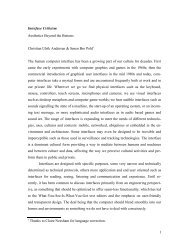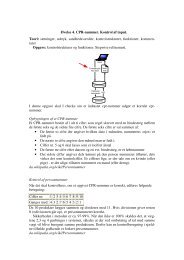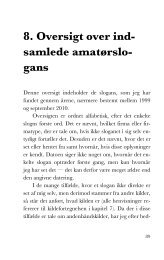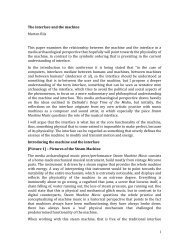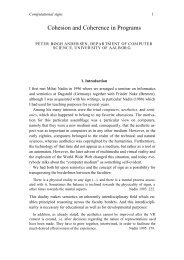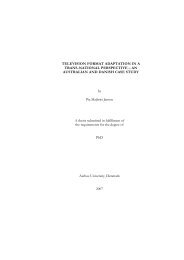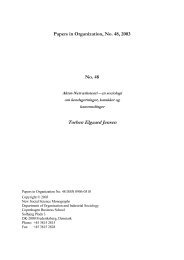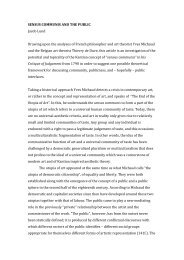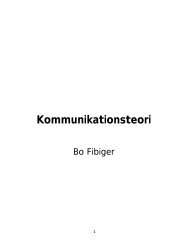Interaction and narration. Tearing Tolkien apart - CiteSeerX
Interaction and narration. Tearing Tolkien apart - CiteSeerX
Interaction and narration. Tearing Tolkien apart - CiteSeerX
Create successful ePaper yourself
Turn your PDF publications into a flip-book with our unique Google optimized e-Paper software.
9<br />
In principle the modality of an event can be promoted or obstructed by manipulating all of its roles.<br />
Since Sauron cannot use the Ring to rule before he has claimed it, he concentrates on the Instrument:<br />
but the action of ruling might be promoted by manipulating the Agent glue (himself, e.g. strengthening<br />
himself) or the Theme glue (Middle Earth, e.g. weakening its inhabitants). Similarly, Frodo<br />
chooses to oppose Sauron by weakening the link between the Ring <strong>and</strong> the event of claiming it in the<br />
most radical way, namely by destroying it, but he could have chosen to disable Sauron in his capacity<br />
of Agent, e.g. by dissuading him (obligation), abducting, or killing him (capability), or he could have<br />
chosen to weaken the ability of the Ring to enter into the claiming event by hiding it, a solution Glorfindel<br />
in fact suggests:<br />
‘Then’, said Glorfindel, ‘let us cast it into the deeps, <strong>and</strong> so make the lies of Saruman come true…<br />
Yet oft in lies truth is hidden: in the Sea it would be safe.’ <strong>Tolkien</strong> 1974, I: 255<br />
It would also have been possible to strengthen Frodo’s capability as an Agent of destruction, e.g. by<br />
training him, or by furnishing him with powerful weapons or mighty armies. Or his obligation could<br />
be strengthened by moral persuasion, but this does not happen either: Elrond says:<br />
‘But it is a heavy burden. So heavy that none could lay it on another. I do not lay it on you. But if<br />
you take it freely, I will say that your choice is right…’ <strong>Tolkien</strong> 1974, I: 255<br />
The reason for this is the dramatic effect: an incapable, non-armed, small person that is not persuaded<br />
by anyone is pitted against the most cunning <strong>and</strong> powerful character in the book.<br />
Summarizing: our basic narrative model consists of four items, actants, events, glue, <strong>and</strong> roles.<br />
We can now describe the first component in the system response (cf. similar ideas in Maes 1989):<br />
(1) Calculate activation level. For all glue-objects of an event, calculate their current values, <strong>and</strong><br />
use these to calculate an activation level for the event. If the level exceeds a threshold, execute<br />
the event.<br />
3.2 Change of glue<br />
The idea is now that the execution of some events makes other events more or less possible by manipulating<br />
the glue between the event roles <strong>and</strong> their fillers. For example, appointing someone to do<br />
something or deciding to do it creates a strong obligation glue between the person <strong>and</strong> the Agent role<br />
of the event, whereas allowing him to do or considering doing it creates a weaker glue. Relieving<br />
someone from a duty or resigning weakens the glue. As shown in Fig. 3.6, Elrond’s appointment of<br />
Frodo as the Ringbearer makes Frodo create a strong obligation glue between the event of destruction<br />
<strong>and</strong> himself.<br />
This is a very detailed level of description, <strong>and</strong> in some cases we need a more general <strong>and</strong> abstract<br />
one. One example is that the gamedeveloper needs an overview over interesting conflicts in the game.<br />
Another example is algorithms that work in a global way, such as the algorithm described in section 5<br />
that globally distributes promotion <strong>and</strong> obstruction relations in the whole game. In order to speed up<br />
such algorithms, a more abstract representation may be necessary, where we just record relations between<br />
events, without caring about the specific ways in which this relation is implemented. In this



